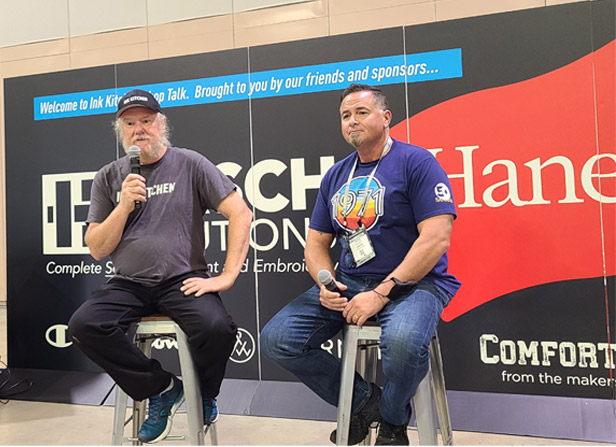News August 30, 2021
With Sustainability, Small Steps Add Up
Rick Roth of Mirror Image and Jason Murphy of SanMar talked about actionable strategies for making decorated-apparel businesses more sustainable during an education session at the Impressions Expo.
Jason Murphy’s kids won’t buy new clothes. Instead, they fill out their wardrobes via thrifting. It’s one of the ways they’re making more sustainable choices as consumers.
Murphy, an executive at Top 40 supplier SanMar (asi/84863), shared the story during the Impressions Expo in Atlantic City not as a way to lament the imminent end of the apparel industry, but rather to show how seriously the younger generations take sustainability.
“Listen to the kids,” he said. “Listen to Gen Z because they’re going to be your next customers.”

Rick Roth (left) of Mirror Image and Jason Murphy of SanMar discussed sustainability in the decorated-apparel industry at an educational session during Impressions Expo in Atlantic City.
Murphy and Rick Roth, owner of Mirror Image in Pawtucket, RI, discussed sustainability best practices for garment decorators, as part of Shop Talk, a series of educational sessions at the expo powered by Roth’s blog The Ink Kitchen.
View this post on Instagram
Sustainability, as a concept, can be overwhelming, but instead of giving up, Roth and Murphy recommend taking a series of smaller initiatives that add up to a cumulative positive impact.
“You don’t have to do everything,” Murphy said. “Track what you do and share it openly.” Doing so, he added, will also help decorators avoid accusations of “greenwashing” – where companies give the appearance of being eco-friendly without taking any steps to do so.
Corporate social responsibility is also an important aspect. “We’ve got to be more mindful of how we treat our people,” Murphy said.
The key to improving sustainability in the industry is education. “You’ve got to dig in and educate yourself and your customers,” Roth said. “All of this needs a lot of explanation.”
That means understanding the different types of fabric used in apparel. Certified organic cotton, for example, has certain standards that must be met in production, including no pesticides or chemical fertilizer used in production for at least three years, Roth said. There’s also “transitional cotton” put out by farms in the process of converting to organic standards. The Better Cotton Initiative (BCI), another option, is not certified organic, but it does set standards for strategic use of fertilizer and reduction of water use in production.
There are more options for apparel made of recycled cotton and synthetic fabrics in the promo industry. And though it’s a good idea to use recycled fabrics, Roth said, there are factors to consider. “In the coming years, you’ll find that [shirts made of cotton-polyester] blends are not a good idea,” he noted. “They may be made of recycled goods, but they’re not recyclable.” Researchers are looking at ways to break down blends into their separate fabric types, but right now it’s not possible.
Another aspect to consider is the ink and other consumables used in apparel decorating. Though on the surface, it seems like water-based inks would be better for the environment than plastisols, there are other factors at play. Water-based ink has a very short shelf life, for example, whereas plastisol can be stored and reused for years, Roth said.
It’s also worth looking at how ink is being used. Roth suggested training customers not to be as stringent about Pantone-matching colors, since that can lead to a lot of ink being discarded if the color is a little off. “Pantone is the devil, as far as I’m concerned, with ink waste,” Roth said.
Other areas where apparel distributors and decorators can work on sustainability include packaging. Mirror Image, for instance, mails out about 20,000 packages a year. So, Roth’s company uses reusable mailers and purposely sends out used boxes, rather than investing in new ones. They include a sticker on the used boxes explaining the reasoning behind the choice, so that customers don’t get upset.
SanMar has made an effort to reduce the use of plastic bags and other packaging materials in its shipments, Murphy said. “We try to use less pins and parts and paper,” he added.
A decade ago, people would use the words “green” and “eco-friendly,” but not really understand what they meant. These days, however, consumers are savvier, and sustainability has become an expectation rather than an extra.
“There seems to be change in the air,” Roth said. “Customers want it, and they ask for it.”
